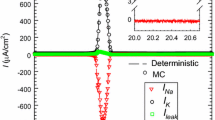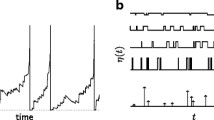Abstract
The numerical simulation of spiking neural networks requires particular attention. On the one hand, time-stepping methods are generic but they are prone to numerical errors and need specific treatments to deal with the discontinuities of integrate-and-fire models. On the other hand, event-driven methods are more precise but they are restricted to a limited class of neuron models. We present here a voltage-stepping scheme that combines the advantages of these two approaches and consists of a discretization of the voltage state-space. The numerical simulation is reduced to a local event-driven method that induces an implicit activity-dependent time discretization (time-steps automatically increase when the neuron is slowly varying). We show analytically that such a scheme leads to a high-order algorithm so that it accurately approximates the neuronal dynamics. The voltage-stepping method is generic and can be used to simulate any kind of neuron models. We illustrate it on nonlinear integrate-and-fire models and show that it outperforms time-stepping schemes of Runge-Kutta type in terms of simulation time and accuracy.











Similar content being viewed by others
Notes
interactions between spikes that are in the same time interval
In particular, since our approach can be seen as a local event-driven technique, all the recently proposed methods to optimize event-driven schemes could be tested and used.
References
Ambard, M., & Martinez, D. (2006). Inhibitory control of spike timing precision. NeuroComputing, 70, 200–205.
Ariav, G., Polsky, A., & Schiller, J. J. (2003). Submillisecond precision of the input–output transformation function mediated by fast sodium dendritic spikes in basal dendrites of ca1 pyramidal neurons. Journal of Neuroscience, 23, 7750–7758.
Bair, W., & Koch, C. (1996). Temporal precision of spike trains in extrastriate cortex of the behaving macaque monkey. Neural Computation, 8, 1185–1202.
Breiman, L. (1993). Hinging hyperplanes for regression, classification, and function approximation. IEEE Transactions on Information Theory, 39, 999–1013.
Brette, R. (2006). Exact simulation of integrate-and-fire models with synaptic conductances. Neural Computation, 18, 2004–2027.
Brette, R. (2007). Exact simulation of integrate-and-fire models with exponential currents. Neural Computation, 19, 2604–2609.
Brette, R., & Gerstner, W. (2005). Adaptive exponential integrate-and-fire model as an effective description of neuronal activity. Journal of Neurophysiology, 94, 3637–3642.
Brette, R., Rudolph, M., Carnevale, T., Hines, M., Beeman, D., Bower, J. M., Diesmann, M., Morrison, A., Goodman, P. H., Harris, F. C., Zirpe, M., Natschlager, T., Pecevski, D., Ermentrout, B., Djurfeldt, M., Lansner, A., Rochel, O., Vieville, T., Muller, E., Davison, A. P., El Boustani, S., & Destexhe, A. (2007). Simulation of networks of spiking neurons: A review of tools and strategies. Journal of Computational Neuroscience, 23, 349–398.
Brunel, N., & Latham, P. (2003). Firing rate of the noisy quadratic integrate-and-fire neuron. Neural Computation, 15, 2281–2306.
Della-Dora, J., Maignan, A., Mirica-Ruse, M., & Yovine, S. (2001). Hybrid computation. ISSAC’01.
DeWeese, M., Wehr, M., & Zador, A. (2003). Binary spiking in auditory cortex. Journal of Neuroscience, 23, 7940–7949.
Ermentrout, G. B. (1996). Type i membranes, phase resetting curves, and synchrony. Neural Computation, 6, 979–1001.
Ermentrout, G. B., & Kopell, N. (1986). Parabolic bursting in an excitable system coupled with a slow oscillation. SIAM Journal of Applied Mathematics, 46, 233–253.
Foldiak, P., & Young, M. (1995). Sparse coding in the primate cortex. In M. Arbib (Ed.), The handbook of brain theory and neural networks (pp. 895–898). Cambridge: MIT.
Fourcaud-Trocmé, N., Hansel, D., van Vreeswijk, C., & Brunel, N. (2003). How spike generation mechanisms determine the neuronal response to fluctuating inputs. Journal of Neuroscience, 23, 11628–11640.
Girard, A. (2002). Approximate solutions of odes using piecewise linear vector fields. 5th international workshop on computer algebra in scientific computing.
Hansel, D., & Mato, G. (2001). Existence and stability of persistent states in large neuronal networks. Physical Review Letters, 10, 4175–4178.
Hansel, D., Mato, G., Meunier, C., & Neltner, L. (1998). On the numerical simulations of integrate-and-fire networks. Neural Computation, 10, 467.
Hubbard, J., & West, B. (1991). Differential equations: A dynamical systems approach. In Texts in applied mathematics (vol. 5). New York: Springer.
Izhikevich, E. (2003). Simple model of spiking neurons. IEEE Transactions on Neural Networks, 14, 1569–1572.
Lytton, W., & Hines, M. (2005). Independent variable time-step integration of individual neurons for network simulations. Neural Computation, 17, 903–921.
Mainen, Z., & Sejnowski, T. (1995). Reliability of spike timing in neocortical neurons. Science, 1503, 268.
Makino, T. (2003). A discrete-event neural network simulator for general neuron models. Neural Computing and Applications, 11, 210–223.
Martinez, D. (2005). Oscillatory synchronization requires precise and balanced feedback inhibition in a model of the insect antennal lobe. Neural Computation, 17, 2548–2570.
Mattia, M., & Del Giudice, P. (2000). Efficient event-driven simulation of large networks of spiking neurons and dynamical synapses. Neural Computation, 12, 2305.
McKean, H. P. (1970). Nagumo’s equation. Advances in Mathematics, 4, 209–223.
Morrison, A., Straube, S., Plesser, H. E., & Diesmann, M. (2007). Exact subthreshold integration with continuous spike times in discrete time neural network simulations. Neural Computation, 19, 44–79.
Perez-Orive, J., Mazor, O., Turner, G. C., Cassenaer, S., Wilson, R. I., & Laurent, G. (2002). Oscillations and sparsening of odor representations in the mushroom body. Science, 297, 359–365.
Rangan, V. A., & Cai, D. (2007). Fast numerical methods for simulating large-scale integrate-and-fire neuronal networks. Journal of Computational Neuroscience, 22, 81–100.
Richardson, M. J. E. (2004). Effects of synaptic conductance on the voltage distribution and firing rate of spiking neurons. Physical Review E, 69, 051918.
Rinzel, J., & Ermentrout, B. (1998). Analysis of sneural excitability. In C. Koch, & I. Segev (Eds.), Methods in neuronal modeling: From ions to networks (pp. 251–291). Cambridge: MIT.
Rochel, O., & Martinez, D. (2003). An event-driven framework for the simulation of networks of spiking neurons. Proc. 11th European symposium on artificial neural networks.
Ros, E., Carrillo, R., Ortigosa, E. M., Barbour, B., & Agis, R. (2006). Event-driven simulation scheme of spiking neural networks using lookup tables to characterize neuronal dynamics. Neural Computation, 18, 2959–2993.
Rudolph, M., & Destexhe, A. (2006). Analytical integrate-and-fire neuron models with conductance-based dynamics for event-driven simulation strategies. Neural Computation, 18, 2305.
Shelley, M. J., & Tao, L. (2001). Efficient and accurate time-stepping schemes for integrate-and-fire neuronal networks. Journal of Computational Neuroscience, 11, 111–119.
Tonnelier, A., & Gerstner, W. (2003). Piecewise linear differential equations and integrate-and-fire neurons: Insights from two-dimensional membrane models. Physical Review E, 67, 021908.
Tonnelier, A., Belmabrouk, H., & Martinez, D. (2007). Event driven simulation of nonlinear integrate-and-fire neurons. Neural Computation, 19, 3226–3238.
VanRullen, R., Guyonneau, R., & Thorpe, S. J. (2005). Spike times make sense. Trends in Neurosciences, 28, 1–4.
Wang, X., & Buzsaki, G. (1996). Gamma oscillation by synaptic inhibition in a hippocampal interneuronal network model. Journal of Neuroscience, 16, 6402–6413.
Acknowledgement
Research supported by the INRIA cooperative research initiative RDNR.
Author information
Authors and Affiliations
Corresponding author
Additional information
Action Editor: Wulfram Gerstner
Appendix: Order of voltage-stepping schemes
Appendix: Order of voltage-stepping schemes
For simplicity, we consider a general neuron model described as follows (notations are defined in Sections 2 and 3)
Over V i , one possible linear interpolation of the function f(v) is achieved by interpolating it at the boundaries v i and v i + 1. Other possible linear interpolations will be discussed in the second part of this appendix.
1.1 Appendix A1: Linear interpolation at boundaries (VS2 method)
Let us consider v Δv the solution of the following dynamical system:
where f Δv is the piecewise linear function defined as follows:
It is straightforward to show that the error of approximation is given by
Considering the following theorem:
Theorem 1
Fundamental Inequality (see for instance Hubbard and West (1991)). For a differential equation \(\dot{x}=F(x)\) satisfying the Lipschitz condition with K ≠ 0 and if u 1(t) and u 2(t) are two continuous, piecewise differentiable functions satisfying \(\left\vert \dot{u}_{i}(t)-F(u_{i}(t)) \right\vert \leq \varepsilon _{i}\) for all t at which u 1(t) and u 2(t) are differentiable and if \(\left\vert u_{1}(0)-u_{2}(0)\right\vert \leq \delta ,\) then
Applying Theorem 1 to Eqs. (13), (14) and using Eq. (15), it can be proved that \(\vert v-v_{\Delta v} \vert =O \left( \Delta v^{2}\right)\). It follows \(\left\vert t_{ex}^f-t_{ap}^f\right\vert=O\left( \Delta v^{2}\right)\) that means that the estimate error on the exact spike time is of order \(O\left( \Delta v^{2}\right)\).
Remarks
-
At the neural network level, the incoming spikes generated by presynaptic neurons introduced a second order error (since \(\left\vert t_{ex}^{f}-t_{ap}^{f}\right\vert =O(\Delta v^{2})\)). Noting the fact that f Δv also introduced a second-order error, the proposed voltage-stepping scheme (VS2) guarantees the same accuracy at the network level as the neuron level, even after considering the effect of propagation of error on spike times.
-
For the p-dimensional case, the only difference is to approximate f(v) over \(V_{i}\subseteq R^{p}\) by a linear system: \(f_{\Delta v}\left( v\right) =A_{i}v+b_{i}\), which is uniquely determined as the linear interpolation vector field of f(v). The same result can be proved using a norm on \(\mathcal{R}^p\), \(\left\Vert \cdot \right\Vert \), instead of the absolute value \(\left\vert \cdot \right\vert \) ( see Girard 2002 for more details).
1.2 Appendix A2: Linear interpolation at gaussian abscissas (VS4 method)
Let us consider (Eq. (13)) and (Eq. (14)) over a voltage interval V i . Without loss of generality, assume that the voltage interval V i + 1 is reached. We have
where \(t_{ex}^{i}\) represents the exact exit time of V i , and \( t_{ap}^{i} \) represents its approximation. The best choice for f Δv is those that minimize (Eq. (16)). We have \(1/f_{\Delta v}(v) \in C^{\infty }\) (almost everywhere). For 1/f(v) ∈ C k, k ≥ 4, and according to Gaussian quadrature rule, the linear interpolation at gaussian abscissas f Δv satisfies
The only point is to calculate the gaussian abscissas over V i . Over \( V_{i}=\left[ v_{i},v_{i+1}\right[\), the gaussian abscissas are:
based on which, the linear interpolation of f(v) can be described as follows:
Over each V i , the local error (approximation of exit time) is of order \( O\left( \Delta v^{5}\right)\). The estimate error on the exact spike time is obtained considering the exit times over the entire voltage-space that gives a global error of \(O\left( \Delta v^{4}\right)\). This error estimate agrees exactly with the results of the numerical simulations.
It should be noted that this method requires one-dimensional neural models. The major reason is that Eq. (17) cannot be always fulfilled in high dimensional case. Moreover the methods also failed for neural network simulation. Assume that we can estimate the incoming spikes generated by presynaptic neurons to an accuracy of \(O\left( \Delta v^{4}\right)\). Therefore a fourth order error is introduced in Eq. (17) and the error can be no better than \(O\left( \Delta v^{4}\right)\) which makes impossible to calculate the exit time with a fifth-order accuracy.
Rights and permissions
About this article
Cite this article
Zheng, G., Tonnelier, A. & Martinez, D. Voltage-stepping schemes for the simulation of spiking neural networks. J Comput Neurosci 26, 409–423 (2009). https://doi.org/10.1007/s10827-008-0119-1
Received:
Revised:
Accepted:
Published:
Issue Date:
DOI: https://doi.org/10.1007/s10827-008-0119-1




